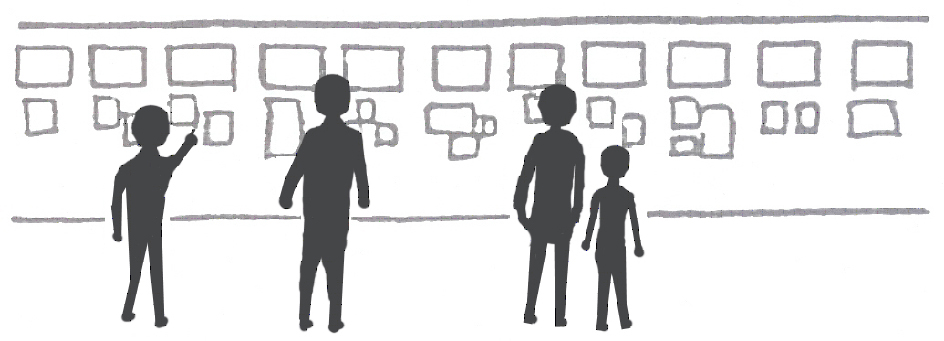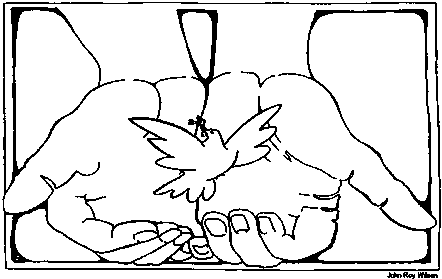For the children of the world . . .
That’s the title of an appeal made at the end of the 1990´s from twenty Nobel Peace Prize winners to the schools and churches, communities and nations of the world, inviting us to promote new ways of dealing with the conflicts and violence that surround us. All too many children grow up immersed in violence. While some progress has been made in addressing the violence in our world, a new emphasis could help a lot.
The Decade for a Culture of Peace 2001-2010 was and still is a unique opportunity for us: a decade-long focus on building a culture of peace and nonviolence in every part of our lives, from schools and churches, to neighborhoods and the world.
Keeping the ball rolling
Talk with others in your congregation who have an interest in peacemaking and nonviolence
Make reconciliation part of your prayer life. Pray for those in conflict in your congregation, and elsewhere . . . Express your gratitude for peacemaking in your family, school, community, and among nations.
Improve your skills of conflict transformation and apply them in your family, congregation, workplace . . .
Add a book or magazine on peace with justice to your reading . . . Use the web to explore peace ideas . . .
Find out what peace and justice groups are doing in your community and globally (Lutheran Peace Fellowship, Bread for the World, Fellowship of Reconciliation . . . )
Bring your values of peace with justice into decisions at work, shopping, investing, and volunteer activity
Exploring shalom
The Decade for a Culture of Peace offered many possibilities for curriculum units, conversations, workshops, and parent/teacher meetings that are still relevant and useful today. Here are several outstanding resources that explore the biblical vision of peacemaking:
Download A Brief Overview of LPF Resources for Leaders (PDF), LPF’s most popular and effective activities and resources for leaders.
STRIVE for Justice and Peace in All the Earth available from ELCA website
ELCA Social Statement on Peace
The Politics of Jesus, John H. Yoder, insightful exploration of nonviolence in Luke (Eerdmans).
Shalom! Toward a More Effective, More Faithful Approach to Conflict and Violence – Our most popular essay explores a more faithful and effective approach to conflict and violence: it is an eye-opening overview, with annotated resource list.
Download Sources for Further Nonviolence Training (PDF) – Annotated listing of outstanding groups.
What is Christian Peacemaking?
This popular activity explores the breadth and depth of the biblical vision of Shalom, peace, justice, community, wholeness. One to six session resource with additional questions and activities to build on or expand the impact of “Jesus’ Way of Shalom”.
Download What Is Christian Peacemaking? (2 page PDF)
Download Jesus’ Way of Shalom (8 page PDF)
¿Qué significa pacificación cristiana? (PDF) – el papel de pacificador esta enraizado en nuestra experiencia de un Dios quien es paz, quien nos da paz, y quien nos llama a ser parte de la paz y la justicia.
Videos and films
A Force More Powerful is a film about the power and spirit of nonviolence; shown on public television.
Bonhoeffer: Agent of Grace is the story of a Lutheran pastor and hero of the resistance in Nazi Germany. Read some of his famous quotes.
International Day of Non-Violence – Gandhi’s Birthday – October 2nd – includes videos about Gandhi´s life and philosophy of nonviolence.
Nonviolence for the Violent – Video of Walter Wink’s explanation of the “Third Way” of Jesus. Illustrating “turn the other cheek”, “offer your coat as well”, and “go the second mile” with lively demonstrations (in 5 parts).
Other feature films, available in video stores, include Weapons of the Spirit, Gandhi, Romero, and A Long Walk Home.
See also:
Using Films to Teach Peace & Justice, Media Violence, Audiovisual Tools for Peacemakers

Digging deeper
The best group discussion and activity program we’ve seen is From Violence to Wholeness, used effectively with 100s of church groups. Assisted by Pace e Bene, which developed the ten-part program, Lutheran Peace Fellowship has worked with congregations and leaders across the U.S. in weekend workshops and weekly discussion series, supported by an Innovations grant from Aid Association for Lutherans (now Thrivent).
The best program for youth groups we’ve seen is called Help Increase the Peace. Like From Violence to Wholeness it has gone through several periods of testing and revision and places the emphasis on participatory activities, not just talk. (American Friends Service Committee, afsc.org)
What Was the Decade for Peace?
Hundreds of Lutheran congregations, school groups, synods, and churchwide organizations endorsed the Nobel Decade for Peace, making a commitment “to teach, practice, and model nonviolence,” in the words of the LPF resolution used by most groups. The Decade was proposed in an Appeal by twenty Nobel Peace Laureates, the largest number ever to support a single initiative. A year after the first Lutheran endorsements, the UN General Assembly designated the years 2001-2010 to be the “International Decade for Culture of Peace and Nonviolence.”
Pledge of Nonviolence
For many people, a commitment or pledge can be a useful tool to help focus their attention on peacemaking in their daily lives. LPF members are finding this discipline helpful.
Family Pledge of Nonviolence Institute for Peace and Justice
Disarming the Heart by John Dear explores the growing practice of professing a vow of nonviolence and how it can lead to new depth in discipleship (Paulist Press, 1993)
Worship
International Day of Prayer for Peace Resource, and Peace Litany
Children’s Sabbath observance: worship, education, outreach and advocacy on the needs of children (Children’s Defense Fund).
A Call to Peace by Jim McGinnis: 52 meditations on the Family Pledge of Nonviolence (Liguori).
Our Prayers Rise Like Incense, edited by Cindy Pile: 50 complete liturgies on peace and justice themes (Pax Christi).
Peace days
There are many dates both in the church year and in the secular calendar that can be used as a focus for peace with justice activity. Here are a few in the fall and winter months:
Sept. 21, UN Day of Peace
Oct. 2, International Day of Non-Violence – Birthday of Gandhi, nonviolence innovator
Oct. 4, feast day of St. Francis of Assisi
Nov. 11, Veterans Day, feast day of St. Martin of Tours (early conscientious objector) and Martin Luther
Dec. 10, UN Human Rights Day
Dec. 28, Holy Innocents
Jan. 1, World Day of Peace
Jan. 15, birth of Martin Luther King, Jr.
Feb. 4, birth of Dietrich Bonhoeffer
Media concerns
While there are beneficial and occasionally even inspiring television shows, movies and video games, researchers and parents alike are disturbed by the impact of the violence in media today. Schools can play an important role.
The Center for Media Literacy offers a wonderful series of video programs for schools, churches, and families that teach skills and encourage group discussion (www.medialit.org)
What to Do After You Turn Off the TV by Frances Moore Lappe is one of many books that offer tips on the question of the title.
Stop Teaching Our Kids to Kill by Dave Grossman and Gloria deGaetano summarizes the links between media violence and violent youth behavior and offers a plan of action.


Our deepest fear is not that we are inadequate. Our deepest fear is that we are powerful beyond measure. It is our light, not our darkness that most frightens us. Your playing small doesn’t help the world. There’s nothing enlightened about shrinking so that other people won’t feel insecure around you. As we let our own light shine, we unconsciously give other people permission to do the same. As we are liberated from our fear, our presence liberates others.
—Nelson Mandela
Reading to grow
Peace Is the Way, edited by Walter Wink, rich and perceptive collection of brief essays on nonviolence. Also check out Nonviolence for the Violent – Walter Wink – video series on our website.
Martin Luther King, Jr.: Spirit-Led Prophet, by Richard Deats is a brief, well-written biography emphasizing the spiritual roots of King’s activity and writing.
The Powers That Be, concise version of Walter Wink’s classic book, Engaging the Powers; both are remarkably rich in stories and insight.
Transforming Violence: Linking Local and Global Peacemaking, edited by Robert and Judy Zimmerman Herr.
Waging Peace in Our Schools by Linda Lantieri and Janet Patti.
![]()
![]()
![]()
Sharing the stories
For many of us, a good way to grasp the meaning of peacemaking today is through the lives and activities and choices of inspiring peace and justice heroes like Bonhoeffer, Gandhi, King, Rosa Parks, Dorothy Day, Nelson Mandela, and Oscar Romero, to name a few. LPF has assembled over a hundred such stories throughout history into a popular display called the Path of Hope. This exhibit has been experienced by 120 classes, groups, and conferences. Constructing one is a superb class or youth project (a how-to kit is available free from Lutheran Peace Fellowship).

Lutheran Peace Fellowship’s work on the Decade for Peace received support from Aid Association for Lutherans (AAL); the ELCA Division for Church in Society; ELCA Commission for Women; Women of the ELCA; and from congregations, synods, and individuals. We are deeply grateful for their assistance.

